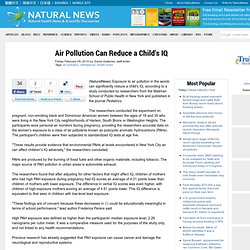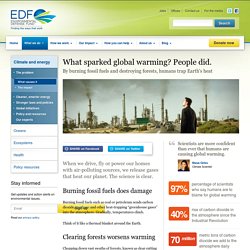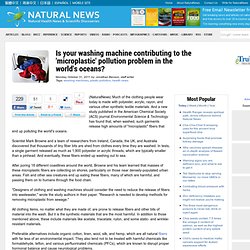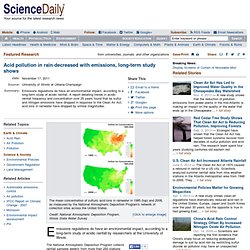

Air Pollution Can Reduce a Child's IQ. (NaturalNews) Exposure to air pollution in the womb can significantly reduce a child's IQ, according to a study conducted by researchers from the Mailman School of Public Health in New York and published in the journal Pediatrics.

The researchers conducted the experiment on pregnant, non-smoking black and Dominican American women between the ages of 18 and 35 who were living in the New York City neighborhoods of Harlem, South Bronx or Washington Heights. The participants wore personal air monitors during pregnancy, providing the researchers accurate data on the women's exposure to a class of air pollutants known as polycyclic aromatic hydrocarbons (PAHs). The participant's children were then subjected to standardized IQ tests at age five. "These results provide evidence that environmental PAHs at levels encountered in New York City air can affect children's IQ adversely," the researchers concluded. Sources for this story include: www.upi.com; latimesblogs.latimes.com. Pollution. NASA instrument tracks pollution from Russian fires.
Drought and the worst heat wave Russia has seen in 130 years have sparked a devastating outbreak of wildfires across the nation this summer, primarily in the country's western and central regions. According to wire service reports and Russia's Emergency Situations Ministry, as of Aug. 6, 2010, some 558 fires were burning. Air Pollution Raises Blood Pressure According to New Study. Warming, Overfishing, Plastic Pollution Destroying Ocean Life: Scientists.
Natural gas industry freely pollutes Pennsylvania's drinking water. (NaturalNews) Drilling for natural gas has become a hot new industry.

But in Pennsylvania, the practice is literally destroying the environment. Unlike other states, Pennsylvania allows the natural gas industry to dump its partially-treated waste into rivers and streams that are used for drinking water, even though the toxic sludge is heavily polluted with salt and dangerous heavy metals. And a recent Associated Press report indicates that the few safeguards that do exist often do not even work.
The report found that more than a fifth of the waste, or 1.28 million barrels, dumped by the industry every year goes unaccounted for because of poor reporting protocols. What is Nonpoint Source Pollution? Motor oil is one source of nonpoint source pollution. (Photo courtesy of NOAA) What is nonpoint source pollution? Nonpoint source pollution generally results from land runoff, precipitation, atmospheric deposition, drainage, seepage or hydrologic modification. The term "nonpoint source" is defined to mean any source of water pollution that does not meet the legal definition of "point source" in section 502(14) of the Clean Water Act.
That definition states: China air pollution: 'Slightly polluted' or 'hazardous'? This photo shows two images of the view from CNN's Beijing Bureau, one from a blue sky day and one from a polluted day.

China rated Beijing air 'slightly polluted' that U.S. standards rated 'hazardous' this weekBeijing officials use equipment from the U.S. to monitor air quality, but standard is lowerPublic complaints over Beijing's worsening air quality on microblogs are commonGovernment has put environmental protection as a priority in its latest 5-year plan Editor's note: Editor's note: "Jaime's China" is a weekly column about Chinese society and politics.
Jaime FlorCruz has lived and worked in China since 1971. He studied Chinese history at Peking University (1977-81) and served as TIME Magazine's Beijing correspondent and bureau chief (1982-2000). How we know human activity is causing warming. When we drive, fly or power our homes with air-polluting sources, we release gases that heat our planet.

The science is clear. Burning fossil fuels does damage Burning fossil fuels such as coal or petroleum sends carbon dioxide, methane and other heat-trapping “greenhouse gases” into the atmosphere. Gradually, temperatures climb. Think of it like a thermal blanket around the Earth. Clearing forests worsens warming. Is your washing machine contributing to the 'microplastic' pollution problem in the world's oceans?
(NaturalNews) Much of the clothing people wear today is made with polyester, acrylic, rayon, and various other synthetic textile materials.

And a new study published in the American Chemical Society (ACS) journal Environmental Science & Technology has found that, when washed, such garments release high amounts of "microplastic" fibers that end up polluting the world's oceans. Scientist Mark Browne and a team of researchers from Ireland, Canada, the UK, and Australia discovered that thousands of tiny fiber bits are shed from clothes every time they are washed. In tests, a single garment released as much as 1,900 polyester or acrylic threads, which are typically smaller than a pinhead. And eventually, these fibers ended up washing out to sea. After poring 18 different coastlines around the world, Browne and his team learned that masses of these microplastic fibers are collecting on shores, particularly on those near densely-populated urban areas. Sources for this article include: Toxic China: Widespread lead pollution is poisoning children. (NaturalNews) Though set to become the world leader in manufacturing within the next few years, China has one of the worst track records for rampant environmental pollution with industrial materials and chemicals.

And a recent report out of the town of Dongtang, which is located in China's major manufacturing region of Guangdong, has revealed that at least 160 local children there have been poisoned by lead pollution released from local factories. Reuters reports that ongoing investigations in the region have revealed "elevated" levels of lead in the blood of many children who live near heavy manufacturing plants.
Infobase Learning - Login. Coal power: air pollution. Burning coal is a leading cause of smog, acid rain, global warming, and air toxics. In an average year, a typical coal plant generates: 3,700,000 tons of carbon dioxide (CO2), the primary human cause of global warming--as much carbon dioxide as cutting down 161 million trees. Pesticides are one of top three 'worst toxic pollution problems' on planet, say non-profit groups. (NaturalNews) The Blacksmith Institute (BI), an international non-profit environmental health organization devoted to solving pollution problems around the world, in conjunction with Green Cross Switzerland (GCS), a group that helps clean up pollution, recently co-released a comprehensive report entitled The World's Worst Toxic Pollution Problems.

In it, researchers explain how agricultural pesticides represent the number three worst pollution problem on the planet. The report was compiled based on data collected over a three year period from thousands of toxic "hotspots" around the world, all of which were in low- and middle-income countries. The team that compiled the report primarily analyzed how various pollutants affect local people groups rather than the world at large, which means the negative effects of these pollutants are far worse on a global scale.
The team also focused on what it calls the "most relevant and urgent" pollutants in terms of toxicity and negative impact. Pesticides. Air Pollution Facts, Air Pollution Effects, Air Pollution Solutions, Air Pollution Causes. Smog hanging over cities is the most familiar and obvious form of air pollution.

But there are different kinds of pollution—some visible, some invisible—that contribute to global warming. Generally any substance that people introduce into the atmosphere that has damaging effects on living things and the environment is considered air pollution. Carbon dioxide, a greenhouse gas, is the main pollutant that is warming Earth. Though living things emit carbon dioxide when they breathe, carbon dioxide is widely considered to be a pollutant when associated with cars, planes, power plants, and other human activities that involve the burning of fossil fuels such as gasoline and natural gas. In the past 150 years, such activities have pumped enough carbon dioxide into the atmosphere to raise its levels higher than they have been for hundreds of thousands of years. Another pollutant associated with climate change is sulfur dioxide, a component of smog.
Pollution. Pollution. At the end of the last century, a great environmental crisis came from above in the form of acid rain. As the precipitation “killed” lakes and streams, alarming studies reported massive die-offs of trees and fish. A 1984 Congressional report estimated that acid rain caused the premature death of about 50,000 people in the United States and Canada. Air pollution news and articles. Acid pollution in rain decreased with emissions, long-term study shows. Emissions regulations do have an environmental impact, according to a long-term study of acidic rainfall by researchers at the University of Illinois.

The National Atmospheric Deposition Program collects rainfall samples weekly from more than 250 stations across the United States and analyzes them for pollutants. The program recently released a report detailing trends in acidic rainfall frequency and concentration over 25 years, from 1984 to 2009.